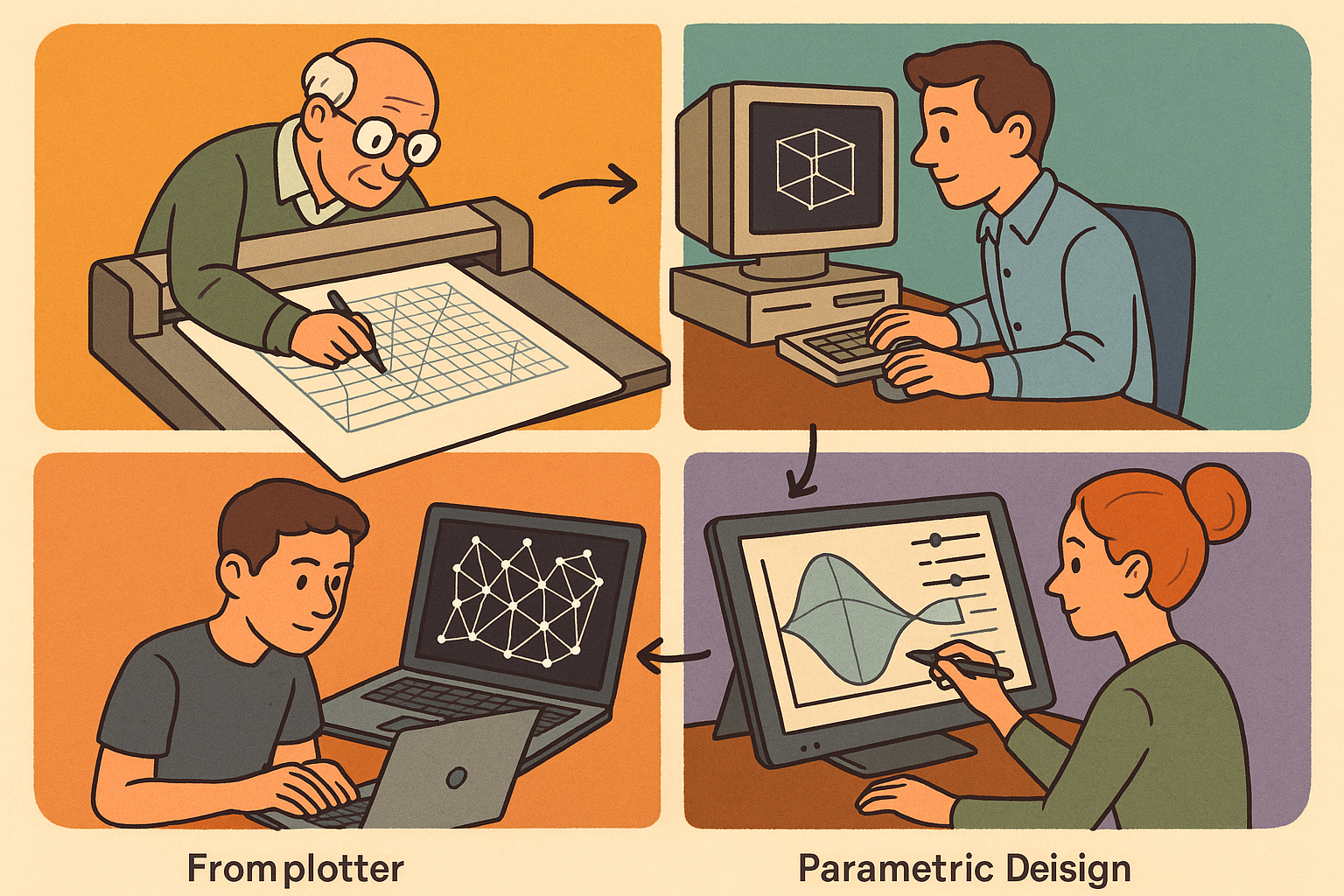Your Cart is Empty
Customer Testimonials
-
"Great customer service. The folks at Novedge were super helpful in navigating a somewhat complicated order including software upgrades and serial numbers in various stages of inactivity. They were friendly and helpful throughout the process.."
Ruben Ruckmark
"Quick & very helpful. We have been using Novedge for years and are very happy with their quick service when we need to make a purchase and excellent support resolving any issues."
Will Woodson
"Scott is the best. He reminds me about subscriptions dates, guides me in the correct direction for updates. He always responds promptly to me. He is literally the reason I continue to work with Novedge and will do so in the future."
Edward Mchugh
"Calvin Lok is “the man”. After my purchase of Sketchup 2021, he called me and provided step-by-step instructions to ease me through difficulties I was having with the setup of my new software."
Mike Borzage
Scalable Design Systems: Enabling Mass Customization with Advanced Software and Technologies
November 14, 2024 5 min read


Introduction
In an era where consumers increasingly crave uniqueness and personalization, mass customization in design has emerged as a pivotal strategy for businesses aiming to meet these evolving demands. Mass customization refers to the capability of producing goods and services that cater to individual customer preferences with near mass production efficiency. This approach combines the flexibility and personalization of custom-made products with the low unit costs associated with mass production. The importance of scalable design systems in this context cannot be overstated, as they provide the necessary infrastructure and tools to manage the complexity and variability inherent in mass customization. Advances in technology have significantly supported scalability in design, enabling companies to efficiently handle complex customization processes without compromising on cost or quality.
The Need for Mass Customization in Today’s Market
The contemporary market landscape is characterized by a significant shift in consumer expectations towards personalized products. Consumers today are not just purchasing products; they are seeking experiences and items that reflect their individual identities and preferences. This desire for personalization has placed immense pressure on traditional manufacturing models, which are typically designed for mass production of homogeneous products. These conventional systems face numerous challenges in meeting the demands of customization, including inflexibility, increased costs, and extended production times when adapting to individual preferences. The rigidity of traditional manufacturing makes it difficult to efficiently produce customized products at scale, leading to a gap between consumer expectations and what businesses can deliver. In response, there is a growing need for scalable design systems that can bridge this gap by enabling mass customization without sacrificing efficiency or profitability. By adopting such systems, businesses can remain competitive, satisfy customer desires for personalization, and navigate the complexities of modern market demands.
Key Features of Scalable Design Systems
At the heart of scalable design systems is the adoption of modular design approaches. Modularity involves creating products from interchangeable components or modules, allowing for easy customization and assembly variations. This approach is significant because it promotes component reuse and simplifies the design process, enabling designers to efficiently create a diverse range of products from a limited set of modules. The reuse of components not only streamlines production but also reduces costs associated with designing and manufacturing unique parts for each product variant.
Another key feature is the integration of advanced design software such as Computer-Aided Design (CAD) and Product Lifecycle Management (PLM) systems. These tools are essential for managing complex design data and workflows, facilitating collaboration among multidisciplinary teams, and ensuring that design changes are accurately reflected throughout the development process. Advanced design software enhances scalability by providing platforms where designs can be easily modified, shared, and implemented across various product lines.
The role of automation and artificial intelligence (AI) cannot be overstated in enhancing design productivity. Automation tools can handle repetitive and time-consuming tasks, such as generating design iterations or performing routine analyses, thereby freeing up creative resources for more critical design challenges. AI can assist in optimizing designs by analyzing large datasets to identify patterns and suggest improvements. The benefits of incorporating automation and AI include:
- Increased Efficiency: Automating repetitive tasks accelerates the design process.
- Enhanced Creativity: Designers can focus on innovative aspects rather than routine work.
- Improved Accuracy: AI reduces human error by handling complex calculations and data analysis.
- Cost Reduction: Streamlining processes leads to lower operational costs.
In summary, scalable design systems are characterized by their modularity, integration with advanced software, and the use of automation and AI. These features collectively enable businesses to efficiently produce customized products at scale, meeting consumer demands while maintaining operational efficiency.
Technologies Enabling Scalable Design Systems
The realization of scalable design systems is heavily dependent on various advanced technologies. One such technology is cloud computing, which provides robust storage solutions and facilitates seamless collaboration among design teams. By leveraging the cloud, designers can access and share large amounts of data in real-time, regardless of their geographic locations. This connectivity enhances team collaboration, accelerates the design process, and ensures that all stakeholders are working with the most up-to-date information.
Another critical technology is the use of advanced parametric modeling tools. These tools allow designers to create models that can easily adapt to different parameters and constraints, which is essential for handling variability in mass customization. Parametric modeling enables the creation of flexible designs that can be rapidly adjusted to meet specific customer requirements without the need to start from scratch each time. This flexibility significantly reduces the time and effort required to produce customized products.
The application of generative design techniques is also a game-changer in scalable design systems. Generative design uses algorithms to explore a vast number of design possibilities based on predefined criteria and constraints. This technology helps designers to efficiently identify optimal design solutions that meet performance requirements while also accommodating customization. By automating the exploration of design options, generative design accelerates innovation and helps in creating more efficient and effective products.
The importance of data management and analytics cannot be overstated. By analyzing customer data, businesses can identify trends and preferences, allowing them to tailor products more precisely to market demands. Key technologies supporting scalable design systems include:
- Cloud Computing: For enhanced storage and real-time collaboration.
- Parametric Modeling Tools: To handle design variability efficiently.
- Generative Design Techniques: To explore multiple design options quickly.
- Data Analytics: For understanding customer preferences and guiding design decisions.
However, the implementation of these technologies is not without challenges. Issues such as data security, the need for significant initial investment, and the requirement for staff training can pose hurdles. Solutions to overcome these challenges include:
- Adopting scalable technology platforms that offer robust security features.
- Implementing phased investment approaches to manage costs effectively.
- Developing continuous learning programs for employees to enhance their skills.
Conclusion
In conclusion, scalable design systems are indispensable in enabling mass customization, allowing businesses to meet the growing consumer demand for personalized products efficiently. By embracing modular design approaches, integrating advanced design software, and leveraging automation and AI, companies can produce a diverse range of products without sacrificing efficiency or significantly increasing costs. The technologies that underpin these systems—such as cloud computing, parametric modeling, and generative design—are continually evolving, offering even greater potential for scalability.
Looking ahead, we can anticipate further advancements in technology that will enhance scalability in design systems. Developments in areas such as machine learning, the Internet of Things (IoT), and additive manufacturing (3D printing) are expected to provide new opportunities for customization and efficiency. These innovations will enable even more responsive and flexible manufacturing processes, further closing the gap between consumer desires and production capabilities.
Design professionals are encouraged to embrace scalable design systems to improve competitiveness and responsiveness to market demands. By adopting these systems, businesses can not only meet current consumer expectations but also position themselves to adapt to future market trends. Embracing scalability in design is not just a competitive advantage; it is rapidly becoming a necessity in the modern marketplace.
Also in Design News

Design Software History: From Plotters to Procedural Intent: A Technical History of Generative and Parametric Design Software
January 04, 2026 13 min read
Read More
Semantic Meshes: Enabling Analytics-Ready Geometry for Digital Twins
January 04, 2026 12 min read
Read MoreSubscribe
Sign up to get the latest on sales, new releases and more …



